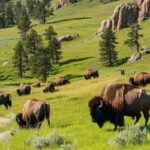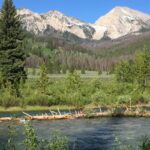Going-to-the-Sun Road, a breathtaking 50-mile route that cuts through Glacier National Park in Montana, is considered one of the most scenic drives in the United States. Winding through towering mountains, lush valleys, and glacial lakes, it offers visitors a chance to experience the majesty of nature up close. However, the beauty of this road is tempered by a number of significant dangers that every traveler should be aware of. Here are six hidden dangers on Going-to-the-Sun Road and important precautions to take to ensure a safe journey.
1. Narrow Roads and Steep Cliffs
One of the most immediate challenges of Going-to-the-Sun Road is its narrow width. With only one lane in each direction, the road hugs the sides of mountains, offering little room for error. In many sections, there are steep drop-offs with limited guardrails. For those unaccustomed to mountain driving, this can be nerve-wracking, particularly around The Loop, the sharpest bend in the road where the sheer cliffs on one side can be intimidating.
Drivers must be especially cautious when navigating these tight spaces, as even a minor mistake could lead to serious consequences. Large vehicles, including trailers and vehicles longer than 21 feet, are prohibited from certain sections because of the narrow lanes. For drivers uncomfortable with these conditions, it’s recommended to travel from east to west, where you’ll be closer to the rock face and further from the cliff edges.
2. Unpredictable Weather Conditions
Weather on Going-to-the-Sun Road can change rapidly, especially at higher elevations such as Logan Pass, which sits at 6,646 feet. Snow, rain, fog, and high winds are common even during the summer months, turning a pleasant drive into a potentially dangerous one within minutes. While the road typically opens fully in late June or early July, heavy snowfalls can cause closures at any time of year.
Sudden fog or rain can reduce visibility to near zero, making the already narrow and winding road even more treacherous. Drivers should check the weather forecast before embarking on the journey and be prepared with appropriate gear, such as layers of clothing, as temperatures can drop unexpectedly.
3. Wildlife on the Road
One of the joys of driving through Glacier National Park is the opportunity to see wildlife. Grizzly bears, mountain goats, bighorn sheep, and deer are common sights along Going-to-the-Sun Road. However, these animals often cross the road without warning, creating a significant hazard for both the wildlife and the drivers.
Collisions with large animals, particularly bears or deer, can be fatal for both the animal and the occupants of the vehicle. Visitors are urged to drive slowly and remain alert, especially during the early morning and late evening hours when wildlife is most active. Keeping a safe distance from animals and not attempting to feed or interact with them is essential to both your safety and the preservation of wildlife.
4. Rockslides and Avalanches
The rugged terrain surrounding Going-to-the-Sun Road is prone to natural hazards such as rockslides and avalanches. Rockfalls can occur without warning, particularly in areas with steep slopes. Logan Pass and the Highline Trail, in particular, are known for occasional rockslides. The road’s maintenance teams work diligently to clear debris, but there’s always a risk when traveling through these sections.
During the spring and early summer, the danger of avalanches remains a real concern as melting snow can trigger massive snow slides. Signs warning of rockslides and avalanche-prone areas are posted along the road, and visitors are encouraged to heed these warnings. Checking road conditions on the National Park Service’s website or with park rangers is highly advisable before setting out.
5. No Cell Phone Coverage
In an age where people rely heavily on GPS and cell phones for navigation, Going-to-the-Sun Road poses a unique challenge: there is little to no cell phone service along most of the route. This lack of coverage means that drivers and hikers must be fully prepared before entering the park. Relying on a smartphone for navigation or emergency assistance can be a serious mistake.
Maps, both paper and downloaded, should be used, and travelers should familiarize themselves with the route before embarking on the journey. In the event of an emergency, help may not be readily available, so it’s crucial to have a plan in place. Visitors are also encouraged to travel with emergency supplies such as water, food, and a first-aid kit.
6. Limited Facilities and Services
Another hidden danger on Going-to-the-Sun Road is the lack of facilities along the route. There are no gas stations within Glacier National Park, meaning travelers must ensure they have enough fuel for the entire journey. The closest fuel stations are located at West Glacier and St. Mary, so filling up before entering the park is essential.
Restroom facilities and places to purchase food or water are limited, especially along the 33-mile stretch between Logan Pass and Lake McDonald. Travelers should pack snacks, water, and other essentials to avoid getting stranded without supplies. The drive itself can take two to three hours without stops, but factoring in scenic overlooks and potential traffic, the journey can easily extend to five or six hours.
Conclusion
Going-to-the-Sun Road offers unparalleled beauty and a truly unforgettable experience, but it also comes with hidden dangers that should not be underestimated. Narrow roads with steep cliffs, unpredictable weather, the presence of wildlife, rockslides, lack of cell phone coverage, and limited facilities all contribute to the challenges of this iconic drive. However, with proper preparation and caution, visitors can safely navigate the road and enjoy one of America’s most breathtaking scenic routes.
Planning ahead—such as fueling up before entering the park, packing essential supplies, checking the weather forecast, and staying alert to wildlife—will ensure a safer and more enjoyable journey. Whether you’re taking in the stunning views of Jackson Glacier, marveling at Logan Pass, or stopping to photograph the picturesque St. Mary Lake, the majesty of Going-to-the-Sun Road is well worth the challenges it presents.






